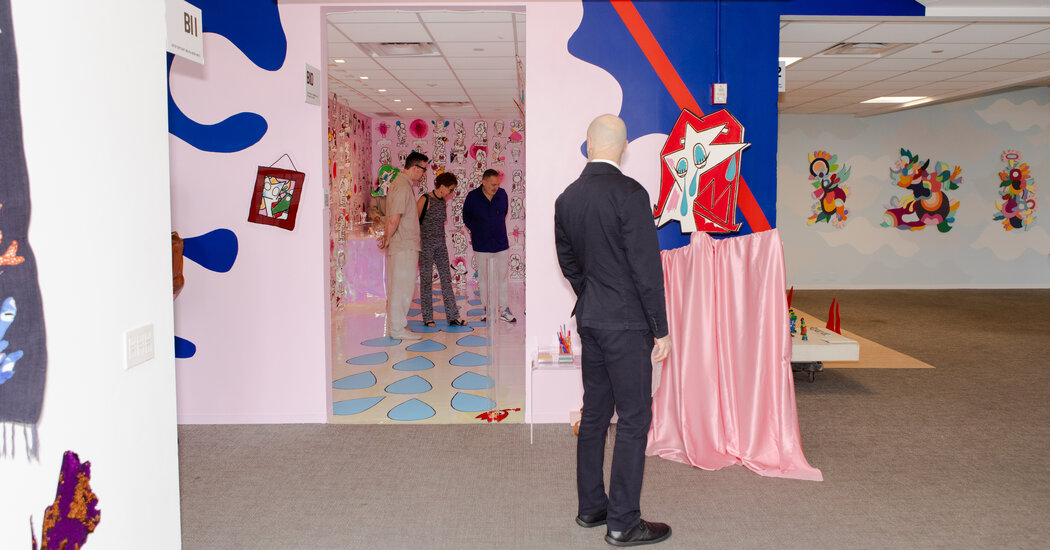When Spring/Break Art Show began in 2012, it was a kind of anti-fair: The married organizers, Andrew Gori and Ambre Kelly, filled an defunct schoolhouse with curated, thematic presentations. Artworks were for sale, but there weren’t really booths so much as rooms and installations. The vibe was D.I.Y., experimental and a bit zany.
More than a decade later, Spring/Break has, perhaps inevitably, grown up. It retains the same system: housed in a disused space — this year, one floor of an office building near Hudson Square — with curators submitting proposals based on a loose theme; for 2025, “Paradise Lost and Found.” There are now solo artist spotlights, too. But the purposefully titled “art show” feels more buttoned-up and closer to the thing it was once bucking against, an art fair. I suppose maturation is inevitable.
What remains rare about Spring/Break is its accessibility: Artists who don’t have gallery representation can show alongside those who do. As with any fair, though, the quality of the work can be mixed. That’s the case with this year’s 120 or so presentations, but it makes finding the good stuff more rewarding. Here are some of my favorites.
The longtime collaborators Eve Sussman and Simon Lee are among the highest-profile and most steadfast Spring/Break participants. And whether they’re curating others’ work or showing their own, their installations tend to be elaborate. This year’s entry, “The Stellas: A Fugue for Day Players,” is a multichannel film made with the composer Volkmar Klien. For it, a series of actors performed a scene from the 1960s soap opera “Peyton Place” while constantly rotating roles and moving through a house. The result feels both high stakes and deconstructed — twin hallmarks of Sussman and Lee’s practice. The installation includes microphones so that anyone can jump in and read lines, becoming a part of the drama.
Eric Diehl (A4)
One indicator of the influence of the market on Spring/Break is the abundance of paintings, which are more sellable than, say, a papier-mâché reconstruction of a home. Among the painters showing this year, many of them figurative, Eric Diehl stands out. His film-inspired American Western scenes are largely devoid of people, instead filled with cars and architecture that frame or impose on the land. They’re meticulously composed and suffused with light that is sometimes ethereal, other times eerie. That changeability hits at the heart of Diehl’s work: Rather than passing judgment, he is attempting to capture a state of isolation that’s as seductive as it is uneasy.
Rosebud Contemporary (A18)
RJ Calabrese’s paintings may be the opposite of Diehl’s: small, claustrophobic and inspiring visceral dread. The cartoonish images depict white men in bizarre spaces and situations involving dismembered body parts, some of which Calabrese fashions from clay and attaches to the works’ wooden surfaces. This is a vision of a systematic hell with people as willing participants. The booth’s second artist, Ebenezer Singh, provides an emotional counterpoint: big, sparkly sculptural tableaus of dinosaurs interacting with Jesus; in one, he stands atop a triceratops. The pieces are funny, sacrilegious and campy. Are they also great? Maybe.
Spring/Break exhibitors have to work with the spaces they get, whether an open area without walls or a corner office. The best entries adapt well, like the curator Indira A. Abiskaroon’s presentation of Aiza Ahmed’s “Border Play.” The project focuses on India and Pakistan’s Attari-Wagah border, where soldiers from both sides perform a highly choreographed daily ceremony for cheering spectators. (The ceremony was suspended this week, after India’s airstrikes on Pakistan.) Ahmed has created a mini-theater for her satire of the spectacle, replete with brushy, life-size caricatures, pink curtains and a red carpet, as well as a video projection.
Taraka Larson (B16)
In 2017, Taraka Larson spent three and half weeks living in a gallery in Austin, Texas, with a snake. The space was part desert habitat, part throwback to her adolescence, and she wrote songs there. The songs became her first solo album, and the installation morphed into what’s here — an imagined, alternative version of her teenage bedroom. Sprawling, handmade and earnest, the project is quintessential Spring/Break, and Larson will be lounging and performing there for the run of the show. When you’ve been at the fair too long, go hang out and chat, or watch her trippy music videos and let them wash over you.
Spring/Break Art Show
Through May 12, 75 Varick Street, Manhattan; springbreakartshow.com.











